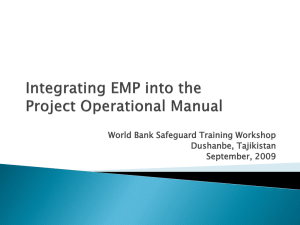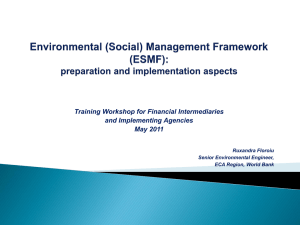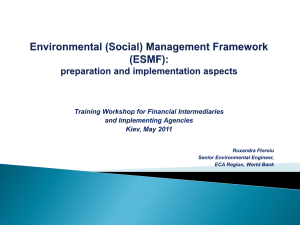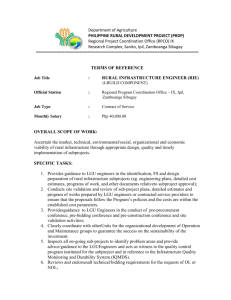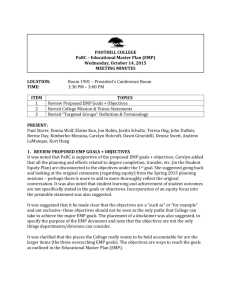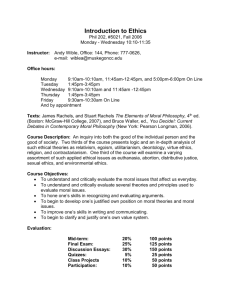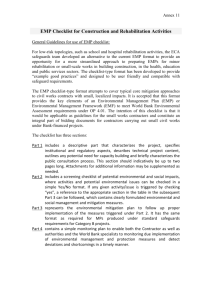Environmental Assessment: Issues and Instruments Environmental
advertisement
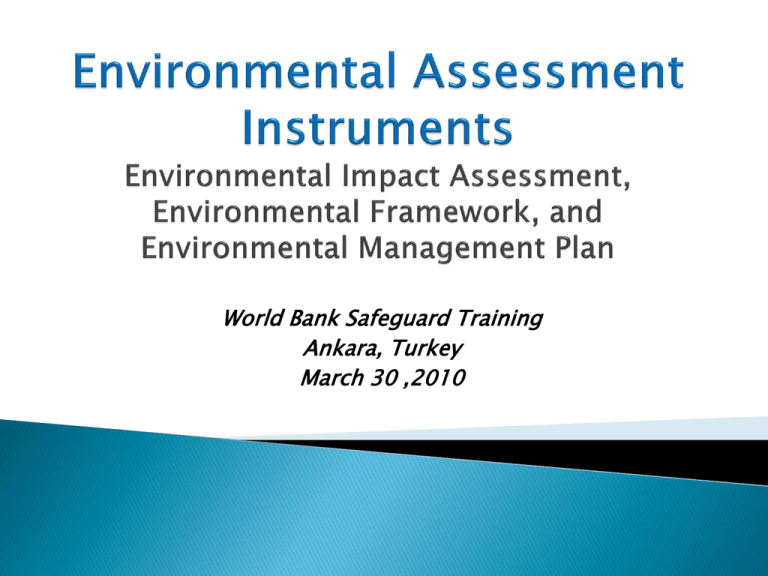
World Bank Safeguard Training Ankara, Turkey March 30 ,2010 Category A: ◦ Full Environmental Impact Assessment (EIA), or ◦ Strategic Environmental Assessment (SEA) Category B: ◦ ◦ ◦ ◦ ◦ Limited Environmental Assessment (EA), or Environmental Management Plan, or Environmental Management Framework, or Environmental Audit, or Hazard or Risk Assessment Category FI: ◦ Environmental Management Framework Identifies and assesses potential risks and benefits based on proposed activities, relevant site features, consideration of natural/human environment, social & transboundary issues Compares environmental pros and cons of feasible alternatives Recommends measures to eliminate, offset, or reduce adverse environmental impacts to acceptable levels (sitting, design, technology offsets) Proposes monitoring indicators to implement mitigation measures Describes institutional framework for environmental management and proposes relevant capacity building needs No (or poor) Executive Summary Inadequate information on methodology and data sources Inadequate or inappropriate baseline information Inadvertent use of “red flag” phrases (“sensitive habitat”) No (or inadequate) analysis of feasible alternatives No (or inadequate) discussion of indirect, cumulative, and transboundary impacts Unclear what mitigation is required, what is recommended Issues raised in EIA, not addressed in EMP “Upstream” planning tool (input to sectoral or regional planning process) Helps identify more vs. less sustainable development pathways Can be OP 4.01 Instrument for programmatic investment ◦ even if Category A projects are included ◦ special emphasis on cumulative impacts Must include SUBSTANCE, not just process (not same thing as EMF) Relatively new instrument; limited guidance, limited capacity and experience • Identify, characterize, evaluate potential environmental risks of expected project investments (EA Category; FI with A and/or B) • Identify which SG Policies apply to overall project • Describe/compare applicable national laws/regulations & WB policies – identify gaps and gap-filling measures • Provide clear and practical operational guidance for project implementers (FI, sub-borrowers) • Assign responsibilities for implementation and monitoring of sub-project level EMPs • Serve as the “Environmental Safeguard” document for disclosure/consultation prior to Appraisal, and for Legal Agreement When specific investments cannot be identified prior to project Appraisal (unknown subprojects are proposed during project implementation): Financial Intermediary (FI) operations Tranched sectoral investment programs (incl. SWAPS) Area development projects (rural, municipal, etc.) Social Funds Small Grants Programs Overview of project Applicable national legislation and WB policies (comparison) Implementation arrangements EA procedures and processes ◦ Sub-project descriptions or eligibility criteria (selection, design, contracting, monitoring, evaluation) ◦ Sub-project EA screening process and guidance (Category A, B, or C): criteria, responsibilities, procedures, guidelines for screening social safeguards ◦ EA/EMP preparation guidelines: EA/EMP templates for each Category (A,B): format, contents, and step-by-step procedures for preparation, disclosure/consultation, approval) Maybe “generic” EA/E(S)MP for common types of investments (to be tailored to individual sub-projects) Monitoring and evaluation: general environmental and social compliance monitoring indicators; reporting templates PROJECT EMF (project level) Sets out requirements & responsibilities for sub-projectspecific EA Disclosure and in-country consultation national level Sub-project Sub-project Preparation, consultation and disclosure prior to Project Appraisal Sub-project Sub-project-specific EIA, EA or EMP Sets out environmental issues and mitigations and monitoring for subproject EA disclosure and consultation at local level(2 for Category A subprojects) Prepared during project implementation •Preparation, In-country disclosure & consultation on EMF & RPF •Prepare Operational Manual; integrate EMF into it •Sub-project EA screening (together with sub-borrowers •Identify EA instruments required •Review sub-project applications for compliance with national and WB requirements • Monitor subproject compliance with environmental mitigation and monitoring plans •Maintain records, files and documents for all subprojects • Report to the Government & Bank on EMF non-compliance • • • • • • • Submit subproject concept to FI Preparation, disclosure and consultation on subproject EA/EMP, and RAP Submit EA/EMP, RAP to FI for review Obtain required permits/licenses Obtain clearance from local/regional environmental authorities Implement sub-project EMP, including supervision of contractors Report to FI on EMP non-compliance • Review and clear sub-projects EAs according to national/local regulatory requirements • Issue permits and licenses • Environmental monitoring and inspections At Appraisal evaluates: ◦ Adequacy of relevant national EA requirements; EMF gap-filling ◦ Adequacy of proposed EA procedures for sub-projects ◦ Capacity of FI and others responsible FI ◦ Arrangements and capacity to implement assessment EMF, and measures in project to strengthen as needed During Implementation: ◦ Prior review/NOB of Category A (sometimes also Category B) sub-project EIAs ◦ Spot-checking of EMF & sub-project EMP implementation, including site visits Environmental Management Framework: KEY FEATURES Used when specific investments CANNOT be identified prior to Appraisal (FI or other program of sub-projects) No provision for EMF in OP 4.01 (evolved to formalize Borrower & WB responsibilities for OP 4.01 compliance of subprojects vis a vis screening, EA/EMP preparation & implementation, monitoring, capacity building, Prior Review Focus on screening criteria, processes, responsibilities No set format; may or may not include technical content Can explicitly exclude high risk subprojects Pelosi Amendment applies if Category A subprojects expected Category A subproject EIAs are submitted to WB Board Sometimes Environmental & Social Management Framework – but DOES NOT REPLACE the RPF (unless written to incorporate RPF as set out in OP 4.12) ISSUES EF not recognized in national legislation, no national mechanism to approve SOLUTIONS Differences between national and WB EA screening criteria, environmental standards FI lacks capacity for EA screening, environmental monitoring EF developed specifically for WB-financed project; Implementing Ministry adopts without formal approval More stringent criteria apply (may require “double” screening) Capacity building within project and/or outsourcing (limit direct WB involvement to high risk subprojects); Category A sub-projects excluded An Action Plan that indicates which of the EA report recommendations and alternatives will actually be adopted and implemented Part of EIA or freestanding The most important link to incorporate environmental factors into the overall project design; Identifies linkages to other SG policies relating to the project Ensures environmental mitigation measures and their practical monitoring become a legal responsibility of the Borrower (LoA) Summary of predicted adverse environmental and social impacts related to project; Description of mitigation measures and plan Description of monitoring activities and plan Institutional arrangements including training Implementation schedule and reporting procedures Estimated related costs and sources of funds ◦ Defines the key environmental (and social) issues which should be managed ◦ Describes specific mitigating measures to manage each possible impact, including specific actions to be achieved Mitigation measures should be feasible and practical; Mitigation measures should be easily observed and checked ◦ Identifies the authorities responsible for mitigation implementation ◦ Includes associated estimated costs ◦ Defines selected indicators for ensuring that mitigation measures are being implemented and are effective (e.g., if there is a mitigating measure to control noise during construction, the monitoring plan should include noise measurements during construction) ◦ Ensures the project is complying with National environmental regulatory requirements and WB Safeguard requirements ◦ Addresses concerns which may rise during the public consultation ◦ Identifies authorities responsible for monitoring ◦ Includes estimated related costs EMP: Typical Mitigation and Monitoring Tables Mitigation Plan: what must be done Monitoring Plan: to determine whether measures are implemented & effective Mitigation measures too general, insufficient detail Mitigation and/or monitoring measures not feasible or not practical Inadequate institutional capacity, insufficient capacity building measures Monitoring indicators not measurable Monitoring targets missing or too general Lack of cost estimates Too long and elaborate to be implemented EMP Checklist: Eligibility Criteria Category “low B” Project Environmental issues known and limited to small scale construction/rehabilitation works (Checklist EMP can be applied to one project component, with regular EMP or EA applied to others) Area of impact clearly defined & limited: either within an existing “footprint” or relatively small new areas known not to have major environmental or social issues EMP Checklist: Structure and Function 1: Datasheet 2: Potential impacts list • Basic information on project activities • Environmental baseline information • Grouped according to various themes or impact types • Themes / types to be checked as applicable 3: Mitigation measures list • Each checked item from Section B triggers specific mitigation measures / parameters and specific, concrete activities to be implemented on site 4: Monitoring plan • Focuses on reasonable, meaningful, practical monitoring parameters and activities EMP Checklist: How it works Example: Country X Real Estate & Cadastre Project (XRECP) Introductory information (to be filled in prior to Appraisal): • Project will finance rehabilitation of 15 Cadastre office buildings, all currently in use (sub-projects) • No new construction or extension of facilities – all works within existing footprint • All buildings located in urban areas on commercial streets with moderate to heavy traffic • Some may be registered historical buildings • Rehabilitation will be interior & exterior including: repair or replacement of roofs & windows, rewiring, removal/replacement of insulation, masonry repairs, replacement of floors, repair/replacement of plumbing, painting • A site-specific Checklist EMP form will be completed for each Sub-project and will be attached to the construction contract EMP Checklist: How it works Subproject Example: Town A 25 EMP Checklist: How it works 26 EMP Checklist: How it works NOTE: Section A always applies EMP Checklist: How it works 29
